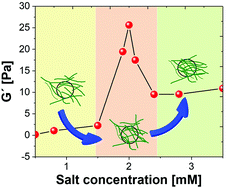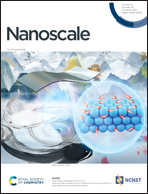Multivalent ion-induced re-entrant transition of carboxylated cellulose nanofibrils and its influence on nanomaterials’ properties†
Abstract
In this work, we identify and characterize a new intriguing capability of carboxylated cellulose nanofibrils that could be exploited to design smart nanomaterials with tuned response properties for specific applications. Cellulose nanofibrils undergo a multivalent counter-ion induced re-entrant behavior at a specific multivalent metal salt concentration. This effect is manifested as an abrupt increase in the strength of the hydrogel that returns upon a further increment of salt concentration. We systematically study this phenomenon using dynamic light scattering, small-angle X-ray scattering, and molecular dynamics simulations based on a reactive force field. We find that the transitions in the nanofibril microstructure are mainly because of the perturbing actions of multivalent metal ions that induce conformational changes of the nanocellulosic chains and thus new packing arrangements. These new aggregation states also cause changes in the thermal and mechanical properties as well as wettability of the resulting films, upon water evaporation. Our results provide guidelines for the fabrication of cellulose-based films with variable properties by the simple addition of multivalent ions.



 Please wait while we load your content...
Please wait while we load your content...